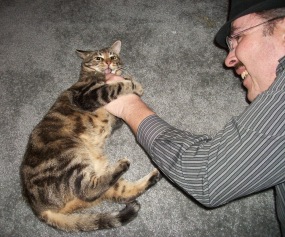Everyone knows that cats sleep for about 15 hours per day, but did you know that cats need at least 30 minutes of vigorous play everyday to stay physically and mentally healthy? There are some things that you should know about being a playful kitty. Manna gives a great demonstration of play at the end of the post.
Being a playful kitty has its benefits.
- Exercise.
In the wild cats are able to get all the exercise their body needs to stay healthy through their hunting. Once we take cats into our homes they no longer need to hunt and there is a need for play as a substitute form of exercise. Playing can keep all of those muscles working and your kitty’s brain functioning optimally. Also, domestic cats are increasingly becoming obese (see my article on feline obesity). Exercise in the form of play can be used to keep your cat from becoming obese or to help your cat overcome obesity. - Beating boredom.
Cats get bored too. Just like in humans, long stretches of boredom can turn into lethargy or worse – depression. Playing with your kitty can help beat the blues! - Bonding with you and your other pets.
Playing with your kitty is a way to spend time with them and let them get to know you. During play, cats learn that you are friendly, fun, and that they can trust you. They can also learn to bond with your other pets through play. - Confidence building.
Creating a warm environment in play can build up your cat’s confidence in its own abilities. Play allows your kitty to practice using their limbs and mouth to reach and hold things, pouncing, jumping, running, and interacting with others. Being a confident cat takes a lot of practice! - Relief from anxiety.
There are many things in a home environment that can cause stress to a cat – loud noises, visitors, other animals, unusual smells, changes in routine, etc. In a cat anxiety can manifest itself in behaviors that humans tend to consider to be “bad” behaviors like marking territory with urine, aggressive behavior, and obsessive-compulsive behaviors. Play allows built up anxiety to be relieved much the same as exercise can release anxiety in humans. A happy kitty is a good kitty.
A playful kitty needs some toys.
Don’t know what to play with? Here are some really fun ideas:
- Cat nip toys. These can be anything from mice to bananas.
- Feather wands.
- Laser toys.
- Games for cats on your smartphone or tablet.
- Milk rings
- Wadded up paper balls. Aluminum foil is a hit too.
- Disposable plastic straws.
- Puzzle feeders.
- Cat trees and scratchers.
Pet supply stores have aisles worth of toys you can choose from if none of the toys above suit your fancy. Keep in mind that cats often like the cheap (or free) toys that you already have at home as much or more than they like expensive toys from the store. Moving a toy mouse or a plastic straw around under a blanket can be the source of hours of entertainment. Cats tend to like playing “fetch” as well.
Tips and Tricks for Playing Along
- Be the prey.
The idea when playing with your kitty is to be the “prey” that they are hunting. Use toys to mimic the behaviors of common cat prey. Think of how a mouse runs around or how a bird flutters in the air. Wiggle the toy as you move it back and forth in front of the cat. Make sudden, short stops. - Use both solo and interactive play.
Solo play is when the cat plays with a toy on its own and interactive play is when you or another living creature plays with the cat. Both types of play are necessary. Make sure that you engage with your cat in play for at least a half an hour (total time). Play times should be broken into smaller segments ( 2 – 15 minute segments, 3 – 10 minute segments, etc). More time will be necessary for younger kittens. - Play at the pace of your cat.
In order to feel confident playing the game, your cat needs time to think about and plan their moves. Let the cat capture the toy occasionally. - Don’t forget the cool down.
If your cat is really riled up, don’t suddenly stop playing. Slow things down like a cool down in exercise. Let the cat get one last “win” before you finish. - Be the keeper of the toys.
Make sure that any toys with long strings are kept out of the cat’s reach when you are not using them to play with your cat. It would be horrible for your cat to swallow or become entangled in any of that string while your back is turned. Always consider the safety risks of leaving a toy out with an unsupervised cat before leaving them out. Leave out some toys for solo play, but consider putting away some of the toys you use for interaction to keep them special.
Cinco chasing the red dot
- Clearly define “toys”.
If there is something you don’t want your cat to play with, don’t use it when engaging in interactive play. When you use something during play, the cat learns that it is a toy. Most cat behavior specialists recommend not allowing cats to play with your hands because they could cause some damage to you when they bite or scratch.
Note: Dave and I have had pretty good success with teaching Cinco and Manna to stop playing with our hands if we say “ouch.” However, we do get a good scratch every now and again.
Manna’s Play Video
Manna wanted to put together a video demonstrating interactive play with a disposable plastic straw. How could I deny her? 😉









